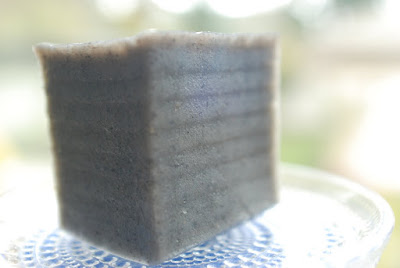I first made a batch of buttermilk muffins following a recipe I copied from a magazine.
 I replaced the chocolate chips with Reese's peanut butter chips...I finally chanced upon these at Cold Storage (Vivo city) a couple of months back...and I have been saving them just for this recipe! Knowing that the use of buttermilk will make bakes very tender, I had very high expectations for these muffins...plus the fact that the recipe was contributed by a local bakeshop and muffins are their speciality. So you would imagine how disappointed I was when the muffins didn't turn out as expected. They were slightly dry, even fresh out of the oven :(
I replaced the chocolate chips with Reese's peanut butter chips...I finally chanced upon these at Cold Storage (Vivo city) a couple of months back...and I have been saving them just for this recipe! Knowing that the use of buttermilk will make bakes very tender, I had very high expectations for these muffins...plus the fact that the recipe was contributed by a local bakeshop and muffins are their speciality. So you would imagine how disappointed I was when the muffins didn't turn out as expected. They were slightly dry, even fresh out of the oven :(Next, I tried making some buttermilk biscuits...hoping that I could yield a batch of nice, buttery biscuits just like those from Popeye's or Mcdonalds. It turned out to be a complete flop...they looked and tasted more like dinner rolls instead! I read that buttermilk biscuits are supposed to be very easy to make...but it proof to be a great challenge for me to cut out the sticky dough into rounds. I guess I have to read up more on these before my next attempt.
On the last day before the leftover buttermilk expires, I managed to squeeze in sometime to bake these Oreo muffins...
 We actually came up with this recipe over a cup of Oreo Mcflurry! When we got home, I retrieved this very much trusted muffin recipe and adapted it according to my family members' wish list. I replaced the milk with buttermilk, and added in crushed oreo cookies and the peanut butter chips. I did noticed that the recipe calls for baking soda...which goes hand in hand with buttermilk. The original recipe calls for melted butter...since I was short of time to melt and let the butter cool off, I replaced it with sunflower oil.
We actually came up with this recipe over a cup of Oreo Mcflurry! When we got home, I retrieved this very much trusted muffin recipe and adapted it according to my family members' wish list. I replaced the milk with buttermilk, and added in crushed oreo cookies and the peanut butter chips. I did noticed that the recipe calls for baking soda...which goes hand in hand with buttermilk. The original recipe calls for melted butter...since I was short of time to melt and let the butter cool off, I replaced it with sunflower oil. These muffins didn't look very pleasing due to the crushed oreos. Nevertheless, they tasted very delicious...moist and fluffy. Not only were they soft and tender, they were also packed with flavours...you can't go wrong with peanut butter chips and oreos?!
These muffins didn't look very pleasing due to the crushed oreos. Nevertheless, they tasted very delicious...moist and fluffy. Not only were they soft and tender, they were also packed with flavours...you can't go wrong with peanut butter chips and oreos?! It was only while trying to compose this post that I learned from the joyofbaking site, that, besides buttermilk, using oil instead of butter will yield very tender muffins...as oil prevents the development of gluten in the flour.
It was only while trying to compose this post that I learned from the joyofbaking site, that, besides buttermilk, using oil instead of butter will yield very tender muffins...as oil prevents the development of gluten in the flour.If you were to ask me how I would rate these muffins...I would say these are the sort of muffins I can give away with confidence to my friends...of course, provided they like Both oreos and peanut butter ;)
Ingredients:
(makes 12 muffins)
250g plain flour
1 1/2 teaspoons baking powder
1/2 teaspoon baking soda
1/2 teaspoon salt
100g Reese's peanut butter chips
8 oreo sandwich cookies (remove fillings, coarsely chopped)
1 egg, lightly beaten
60ml vegetable oil
175ml buttermilk
125g granulated sugar
Method:
- Pre-heat oven to 180degC (350 degF).
- Sieve together flour, baking powder, baking soda and salt into a mixing bowl. Add peanut butter chips, crushed oreo biscuits and mix with a spatula. Make a well in the centre.
- Place egg, oil, buttermilk and sugar in another bowl. Mix (with a manual whisk) until thoroughly combined.
- Pour the liquid mixture into the dry ingredients. With the spatula, gently fold all the ingredients to form a wet batter. Just mix until the flour are incorporate into the batter. DO NOT Over mix. The batter will appear lumpy.
- Spoon batter into paper muffin cups. Bake for 20mins until muffins turn golden brown or a toothpick inserted into the centre comes out clean.
- Let cool on a wire rack.



 I was at the local market handling a perfectly ripe avocado when the craving hit. I immediately added the avocado to my basket along with some of that fake crabmeat (surimi) made out of pollock. A fish with such an unappealing name surely needs to be processed into something else.
I was at the local market handling a perfectly ripe avocado when the craving hit. I immediately added the avocado to my basket along with some of that fake crabmeat (surimi) made out of pollock. A fish with such an unappealing name surely needs to be processed into something else.

















































